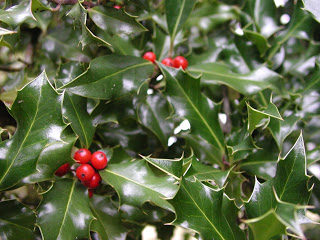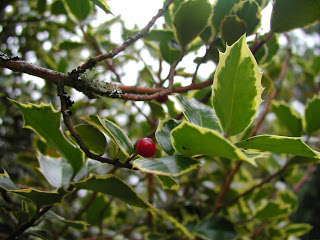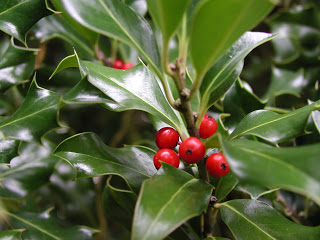“For most of us the sight of holly leaves and berries is inextricably linked with Christmas, whether we celebrate this as a secular or a religious festivity. Christmas brings with it many traditions and it is probably the one time when many of us still practice at least a few old folklore customs today. Indeed in some parts of Britain holly was formerly referred to merely as Christmas, and in pre-Victorian times ‘Christmas trees’ meant holly bushes.
Though holly doubtless was, and still is, brought into the house for its shiny green leaves and berries, which reflect the light and add colour to the dark days of Yule, it has another significance as well. Christian symbolism connected the prickly leaves with Jesus’ crown of thorns and the berries with the drops of blood shed for humanity’s salvation, as is related, for example, in the Christmas carol, ‘The Holly and the Ivy’. Yet even here the reference to these two plants refers to a pre-Christian celebration, where a boy would be dressed in a suit of holly leaves and a girl similarly in ivy, to parade around the village, bringing Nature through the darkest part of the year to re-emerge for another year’s fertility.
Holly was also brought into the house variously to protect the home from malevolent faeries or to allow faeries to shelter in the home without friction between them and the human occupants. Whichever of prickly-leaved or smooth-leaved holly was brought into the house first dictated whether the husband or wife respectively were to rule the household for the coming year.
In Celtic mythology the Holly King was said to rule over the half of the year from the summer to the winter solstice, at which time the Oak King defeated the Holly King to rule for the time until the summer solstice again. These two aspects of the Nature god were later incorporated into Mummers’ plays traditionally performed around Yuletide. The Holly King was depicted as a powerful giant of a man covered in holly leaves and branches, and wielding a holly bush as a club. He may well have been the same archetype on which the Green Knight of Arthurian legend was based, and to whose challenge Gawain rose during the Round Table’s Christmas celebrations.
However the folklore of the holly is not solely connected with Yuletide festivities. Like several other native trees it was felt to have protective properties, and there were taboos against cutting down a whole tree. Hollies were frequently left uncut in hedges when these were trimmed. A more arcane reason for this was to obstruct witches who were known to run along the tops of hedges, though more practically farmers used their distinctive evergreen shapes to establish lines of sight during winter ploughing. Apparently the Duke of Argyll even had a prospective road rerouted to avoid cutting down a distinctive old holly in 1861.
Although the felling of whole trees was said to bring bad luck, the taking of boughs for decoration, and the coppicing of trees to provide winter fodder, was allowed. Holly leaves proved to be particularly nutritious as winter feed for livestock, and some farmers even installed grinders to make the pricklier leaves more palatable. Coppicing also allowed the holly’s hard, white, close-grained wood to be used for inlaid marquetry and to make chess pieces and tool handles. Folklore suggested that the wood had an affinity for control, especially of horses, and most whips for ploughmen and horse-drawn coaches were made from coppiced holly, which accounted for hundreds of thousands of stems during the eighteenth century.
In Scotland the Gaelic name for holly, Chuillin, appears across the country from Cruach-doire-cuilean on Mull, where the local McLean clan adopted holly as their clan badge, to Loch a’ Chuillin in Ross-shire in the north; the town of Cullen in Banffshire may also have derived its name from a local holly wood.



Very informative, thanks for sharing. Happy Holidays!
That was a lovely history of the Holly! Thank you- not many people bother to find out why it is linked to the holidays!
Blessings,
Holly